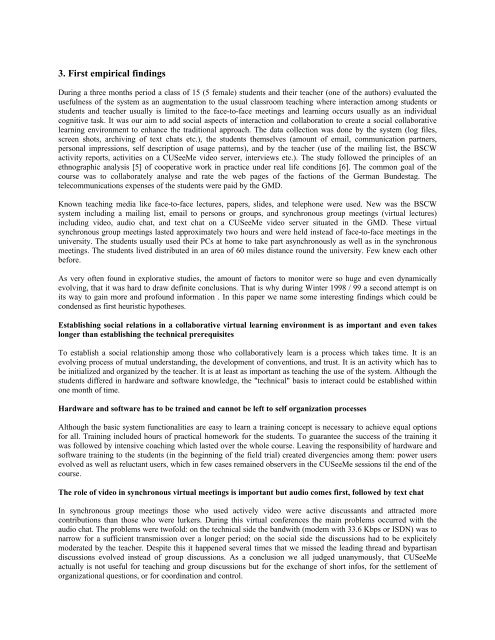ED-MEDIA 1999 Proceedings Book - Association for the ...
ED-MEDIA 1999 Proceedings Book - Association for the ...
ED-MEDIA 1999 Proceedings Book - Association for the ...
Create successful ePaper yourself
Turn your PDF publications into a flip-book with our unique Google optimized e-Paper software.
3. First empirical findings<br />
During a three months period a class of 15 (5 female) students and <strong>the</strong>ir teacher (one of <strong>the</strong> authors) evaluated <strong>the</strong><br />
usefulness of <strong>the</strong> system as an augmentation to <strong>the</strong> usual classroom teaching where interaction among students or<br />
students and teacher usually is limited to <strong>the</strong> face-to-face meetings and learning occurs usually as an individual<br />
cognitive task. It was our aim to add social aspects of interaction and collaboration to create a social collaborative<br />
learning environment to enhance <strong>the</strong> traditional approach. The data collection was done by <strong>the</strong> system (log files,<br />
screen shots, archiving of text chats etc.), <strong>the</strong> students <strong>the</strong>mselves (amount of email, communication partners,<br />
personal impressions, self description of usage patterns), and by <strong>the</strong> teacher (use of <strong>the</strong> mailing list, <strong>the</strong> BSCW<br />
activity reports, activities on a CUSeeMe video server, interviews etc.). The study followed <strong>the</strong> principles of an<br />
ethnographic analysis [5] of cooperative work in practice under real life conditions [6]. The common goal of <strong>the</strong><br />
course was to collaborately analyse and rate <strong>the</strong> web pages of <strong>the</strong> factions of <strong>the</strong> German Bundestag. The<br />
telecommunications expenses of <strong>the</strong> students were paid by <strong>the</strong> GMD.<br />
Known teaching media like face-to-face lectures, papers, slides, and telephone were used. New was <strong>the</strong> BSCW<br />
system including a mailing list, email to persons or groups, and synchronous group meetings (virtual lectures)<br />
including video, audio chat, and text chat on a CUSeeMe video server situated in <strong>the</strong> GMD. These virtual<br />
synchronous group meetings lasted approximately two hours and were held instead of face-to-face meetings in <strong>the</strong><br />
university. The students usually used <strong>the</strong>ir PCs at home to take part asynchronously as well as in <strong>the</strong> synchronous<br />
meetings. The students lived distributed in an area of 60 miles distance round <strong>the</strong> university. Few knew each o<strong>the</strong>r<br />
be<strong>for</strong>e.<br />
As very often found in explorative studies, <strong>the</strong> amount of factors to monitor were so huge and even dynamically<br />
evolving, that it was hard to draw definite conclusions. That is why during Winter 1998 / 99 a second attempt is on<br />
its way to gain more and profound in<strong>for</strong>mation . In this paper we name some interesting findings which could be<br />
condensed as first heuristic hypo<strong>the</strong>ses.<br />
Establishing social relations in a collaborative virtual learning environment is as important and even takes<br />
longer than establishing <strong>the</strong> technical prerequisites<br />
To establish a social relationship among those who collaboratively learn is a process which takes time. It is an<br />
evolving process of mutual understanding, <strong>the</strong> development of conventions, and trust. It is an activity which has to<br />
be initialized and organized by <strong>the</strong> teacher. It is at least as important as teaching <strong>the</strong> use of <strong>the</strong> system. Although <strong>the</strong><br />
students differed in hardware and software knowledge, <strong>the</strong> "technical" basis to interact could be established within<br />
one month of time.<br />
Hardware and software has to be trained and cannot be left to self organization processes<br />
Although <strong>the</strong> basic system functionalities are easy to learn a training concept is necessary to achieve equal options<br />
<strong>for</strong> all. Training included hours of practical homework <strong>for</strong> <strong>the</strong> students. To guarantee <strong>the</strong> success of <strong>the</strong> training it<br />
was followed by intensive coaching which lasted over <strong>the</strong> whole course. Leaving <strong>the</strong> responsibility of hardware and<br />
software training to <strong>the</strong> students (in <strong>the</strong> beginning of <strong>the</strong> field trial) created divergencies among <strong>the</strong>m: power users<br />
evolved as well as reluctant users, which in few cases remained observers in <strong>the</strong> CUSeeMe sessions til <strong>the</strong> end of <strong>the</strong><br />
course.<br />
The role of video in synchronous virtual meetings is important but audio comes first, followed by text chat<br />
In synchronous group meetings those who used actively video were active discussants and attracted more<br />
contributions than those who were lurkers. During this virtual conferences <strong>the</strong> main problems occurred with <strong>the</strong><br />
audio chat. The problems were twofold: on <strong>the</strong> technical side <strong>the</strong> bandwith (modem with 33.6 Kbps or ISDN) was to<br />
narrow <strong>for</strong> a sufficient transmission over a longer period; on <strong>the</strong> social side <strong>the</strong> discussions had to be explicitely<br />
moderated by <strong>the</strong> teacher. Despite this it happened several times that we missed <strong>the</strong> leading thread and bypartisan<br />
discussions evolved instead of group discussions. As a conclusion we all judged unanymously, that CUSeeMe<br />
actually is not useful <strong>for</strong> teaching and group discussions but <strong>for</strong> <strong>the</strong> exchange of short infos, <strong>for</strong> <strong>the</strong> settlement of<br />
organizational questions, or <strong>for</strong> coordination and control.
















